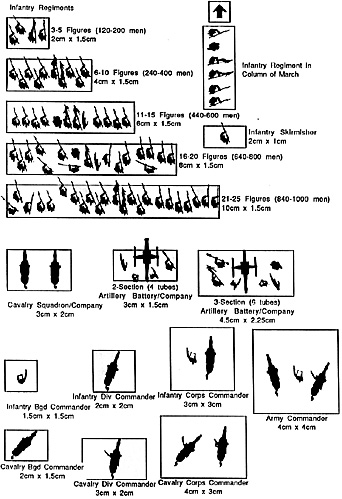While Many gamers have adopted Stars*N*Bars 3rd Edition (SNB3), there are still many who are devoted to other systems. This is not at all surprising. Gamers spend many hours learning rules and building armies in conformity with those rules' requirements. It is then difficult to justify throwing that time investment out the window and reorganizing one's troops for a system that not all gamers in the group are willing to adopt.
A new situation, however, may be developing. I have never liked 5mm figures, and I have never even considered using them. After all, if I am going to use troops that small, why not just cut out cardboard counters? But an English company called Ten High now has a line of lOmm figures for the American Civil War. My first reaction was, "Why would anybody buy 10mm figures? How different are they from 15mm figures, already a widely accepted scale?" I soon became aware of some of the advantages. First, a package of 25 infantry figures costs $2, about half that of 15mm castings. That means in SNB3, a Union corps can cost less than $40.00.
I became aware of the 2nd advantage after a friend gave me some castings to paint. I painted and mounted a brigade of 30 infantry in about two and a half hours. Three brigades and a cavalry regiment took no more than eight flours to paint and mount.
The third advantage became apparent when I began to fiddle around with modifications to SNB3 that would allow the 10mm castings to be utilized. We have adopted a ground scale of 1cm = 36 yards (see below for an explanation). This would allow a battle the size of Gettysburg to be played on a 61 X 121 table, something that can be imagined in a two car garage.
All of these advantages finally sold me on the idea of adopting the 10mm castings for my ACW armies. In my opinion these advantages outweigh the disadvantages, which are the crude nature of the castings and the obsolescence of my 15mm armies. The remainder of this article is devoted to explaining flow to adapt SNB3 to the. use of 10mm figures.
MOUNTING: We have adopted a slightly modified system in this smaller scale. That is, infantry are mounted on a single regimental stand. If there are 3-5 figures in a regiment, then the stand size is 2cm X 1.5cm. The following covers stand sizes for various strength regiments: 6-10 figures = 4cm X 1.5cm; 11-15 figures = 6cm X 1.5cm; 16-20 figures = 8cm X 1-5cm; and 21-25 figures = 10cm X 1-5cm (an unusual. occurrence indeed). This system recognizes the fact that the field column has little tactical significance in SNB3. It makes moving easier, and in no way reduces the flexibility of the formations. If a road column in desired, simply place a chit with an arrow on one end of the unit indicating its facing (counters from JOHNNY REB are useful.).
In the 10mm scale we have decided to utilize a more abstract method for artillery than is presented in the original rules. A battery (or company) will have a frontage equal to 7.5mm per GUN. Thus, a four gun battery will have a frontage of 3cm (30mm). The depth of the battery should be half of its frontage. In this way, compressed frontage can be represented by facing the battery sideways and pointing the gun model out the side. Each artillery stand should have one artillery model and a number of crewmen equal to the. number of guns in the battery. Companies of mixed guns must have the composition of the battery recorded on the bottom of the stand, or otherwise noted.
Cavalry is mounted more like the original rules describe. A two figure stand has a frontage of 3cm and a depth of 2cm. A single figure stand has a frontage of 1.5cm and a depth Of 2cm. Two figure stands are recommended, but larger multiples might be utilized.
GROUND SCALES: We have found a very simple way to adapt SNB3 to the 10mm scale without the difficulty of modifying the ranges printed on the "quick reference sheets". A ground scale of 1cm = 36 yards has been adopted. This means simply that one can use the ranges provided on the charts for the 25mm scale, but interpret the ranges in centimeters rather than inches. For example, engagement range in the 10mm scale is 16cm, infantry in line moves 20cm in a tactical impulse, etc.
In all other respects the rules remain the same (with the addition of any house rules that you feel might enhance the flavor of your simulations). I hope that you will find these adaptations useful. There is much to be -said for going to 10mm in SNB3. Before you decide that you have too much invested in 15mm or 25mm castings, consider the advantages of the. 10mm figures for cost, rapidity of painting, and size of battles that can be simulated.

Back to The Zouave Vol II No. 3 Table of Contents
Back to The Zouave List of Issues
Back to Master Magazine List
© Copyright 1988 The American Civil War Society
This article appears in MagWeb (Magazine Web) on the Internet World Wide Web.
Other military history articles and gaming articles are available at http://www.magweb.com